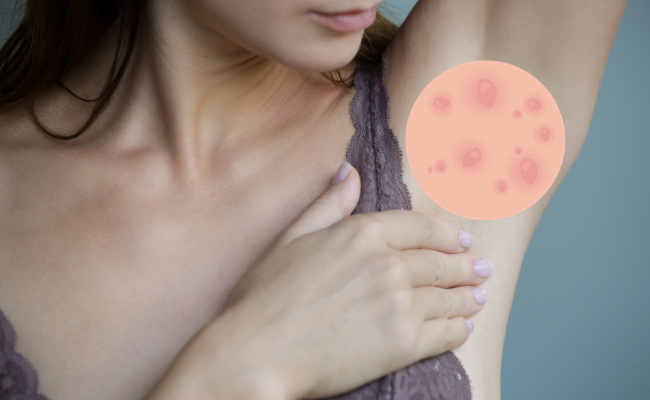How to Treat Hidradenitis Suppurativa?
- January 10, 2024
- No Comments

What is Hidradenitis Suppurativa (HS)?
Hidradenitis Suppurativa (HS), also known as acne inversa, is a chronic skin condition that results in the formation of painful boils, abscesses, and tunnels beneath the skin. This condition primarily affects areas where skin rubs together, such as the armpits, groin, buttocks, and under the breasts. HS is characterized by recurring flare-ups, leading to discomfort and potential complications. While there is no cure, treatment options are available to manage symptoms, prevent new boils, and minimize scarring.
Why Does Hidradenitis Suppurativa Occur?
The exact cause of Hidradenitis Suppurativa is complex and not fully understood. It is believed to result from a combination of genetic, environmental, and lifestyle factors. HS often begins after puberty, and it is more prevalent in women. While obesity, metabolic syndrome, and a family history of HS are considered risk factors, the exact interplay of these elements in causing the condition is still an area of active research.
One theory suggests that HS may begin with inflammation of hair follicles, leading to the formation of abscesses, tunnels, and scarring. Additionally, factors such as hormonal changes, excess weight, and a compromised immune system may contribute to the development and exacerbation of HS symptoms.
How to Manage Hidradenitis Suppurativa: Lifestyle and Self-Care
While Hidradenitis Suppurativa has no cure, various strategies can help manage symptoms and improve overall well-being. Lifestyle modifications and self-care practices play a crucial role in minimizing the impact of the condition.
- Maintain Good Hygiene: Keeping the affected areas clean is fundamental in preventing infection and reducing the severity of flare-ups. Using a mild, fragrance-free soap and avoiding harsh scrubbing helps maintain skin integrity.
- Wear Loose-Fitting Clothing: Tight clothing can worsen friction and irritation, leading to increased inflammation and more severe flare-ups. Opting for loose-fitting, breathable fabrics minimizes friction, allowing the skin to breathe and promoting comfort.
- Weight Management: Maintaining a healthy weight is beneficial for individuals with Hidradenitis Suppurativa, as excess weight may contribute to increased friction and inflammation. A balanced diet and regular exercise can help manage weight and improve overall well-being.
- Avoid Smoking: Smoking has been linked to the worsening of Hidradenitis Suppurativa symptoms. Quitting smoking can have positive effects on the condition and overall skin health.
- Stress Management: Stress is a known trigger for Hidradenitis Suppurativa flare-ups. Incorporating stress-reducing activities such as meditation, yoga, or deep breathing exercises into daily life may help manage symptoms and reduce the frequency of flare-ups.
Treatment Solutions for Hidradenitis Suppurativa
- Topical Treatments: Dermatologists often prescribe topical antibiotics, corticosteroids, or retinoids to reduce inflammation and prevent infection. These medications are applied directly to the affected skin, targeting the surface layers of the lesions.
- Systemic Medications: In more severe cases, dermatologists may prescribe oral antibiotics or immunosuppressant medications to address widespread inflammation. These medications work from within the body to control the immune response and reduce the severity of symptoms.
- Biologics: Biologic medications, such as adalimumab, have shown promise in managing Hidradenitis Suppurativa. These drugs target specific components of the immune system to reduce inflammation and control symptoms. Biologics are typically reserved for cases that are resistant to other forms of treatment.
- Incision and Drainage: For painful abscesses or nodules, a healthcare professional may perform incision and drainage to relieve pressure and promote healing. This procedure is usually done under local anesthesia and can provide rapid relief for localized symptoms.
- Laser Therapy: Laser treatments, including carbon dioxide laser therapy, have been explored as a potential option for managing Hidradenitis Suppurativa. These treatments aim to reduce inflammation and promote healing of lesions, although individual responses may vary.
Benefits of Early Detection and Treatment
- Pain Reduction: Early detection and intervention can significantly contribute to the management of pain associated with Hidradenitis Suppurativa. By addressing symptoms promptly, individuals can experience relief and an improved overall sense of well-being.
- Prevention of Complications: Timely treatment can prevent the progression of the condition and reduce the risk of complications such as scarring, tunneling, or the formation of sinus tracts beneath the skin. Early intervention aims to minimize the impact on skin integrity and structure.
- Improved Quality of Life: Managing Hidradenitis Suppurativa effectively contributes to an enhanced quality of life. By minimizing symptoms, individuals can engage more fully in daily activities without the hindrance of pain and discomfort. The ability to participate in work, social interactions, and recreational activities is positively influenced by effective symptom management.
- Psychological Well-Being: Hidradenitis Suppurativa can take a toll on mental health due to the physical appearance of lesions and the chronic nature of the condition. Early treatment can positively impact psychological well-being by addressing both the physical and emotional aspects of the disorder. The reduction of visible symptoms and discomfort contributes to an improved self-image and mental health.
Comments (0)